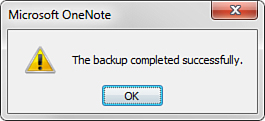Immediately Backing Up All Changed Files
If you created or changed an important quantity of important notes and you do not want to expect the next interval of autosaving, you can immediately create a support of all your changed files:
1. | Click the File tab and then click Options.
|
2. | On the left side of the OneNote Options dialog box that appears, click the Save & Backup category.
|
3. | On
the right side of the dialog box, under the Backup heading, click the
Back Up Changed Files Now button. After a moment, you should see a
confirmation message that tells you that the backup was created
successfully (see Figure 3).

|
4. | At the bottom of the OneNote Options dialog box, click OK.
|
Immediately Backing Up All Notebooks
Similar to the previous procedure, you can create a
manual, immediate backup of all of your notebooks whenever you want or
need to. This is most useful if you’ve created or changed a significant
amount of important notes across multiple notebooks and you don’t want
to wait for the next automatic backup interval.
To create an immediate backup, do the following:
1. | Click the File tab and then click Options.
|
2. | On the left side of the OneNote Options dialog box that appears, click the Save & Backup category.
|
3. | On
the right side of the dialog box, under the Backup heading, click the
Back Up All Notebooks Now button. After a moment, you should see a
confirmation message that tells you that the backup was created
successfully (see Figure 3).
|
4. | At the bottom of the OneNote Options dialog box, click OK.
|
Copying Your Notebooks to a USB Drive
Finally, there’s a quick-and-dirty way to create a
complete, manual backup of all of the notebooks stored on your
computer’s hard drive. If you’re still experimenting with the automatic
backup settings I discussed in the previous procedures, you might want
to create a complete, manual backup set of all of your notebooks.
Typically, I don’t recommend this option as a valid
backup method because it creates a separate version of all of your
notes. If you create too many copies of all of your notes, you might
confuse yourself about which set is most current. However, I’m
including this here as a final backup tip because it’s really the
simplest and fastest way to an instant notebooks’ insurance policy.
To back up all of your notebooks to a USB drive, do the following:
1. | Connect
your USB drive to your computer. For the highest reliability, connect
USB drives only to the ports on your computer, not to USB hubs or USB
extension cords.
|
2. | In Windows Explorer, navigate to your Documents (or My Documents) folder. |
3. | Right-click the folder labeled OneNote Notebooks and then click Copy on the shortcut menu.
|
4. | Navigate
to the contents of your USB drive. Right-click over a blank area in the
window (not over any existing folders there), and then click Paste on
the shortcut menu. OneNote will copy the entire OneNote Notebooks
folder from your hard drive to your USB drive.
|
|
If you might confuse yourself with having multiple
OneNote Notebooks folders appearing on multiple drives, consider
renaming the copied folders on your USB drive by appending the date of
the backup to the folder name. Alternately, you could also create a
Readme text file in the same location, in which you briefly describe
the purpose of the manual backup (for example, “Backup of all notebooks
before major revisions on September 1, 2011”).
If you opt for this method of creating quick, manual
backups of all of your OneNote files, be sure never to move or rename
the original OneNote Notebooks folder (nor its subfolders) in your
Documents (or My Documents) folder.
|